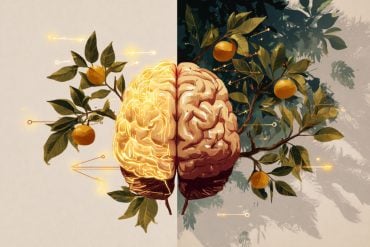Summary: 90 percent of the population can be classified into one of four main personality types, and of those, 30 percent fall under the envious personality type, a new study reports.
Source: Carlos III University of Madrid.
A study on human behavior has revealed that 90 percent of the population can be classified into four basic personality types: optimistic, pessimistic, trusting and envious. However, the latter of the four types, envious, is the most common, with 30 percent compared to 20 percent for each of the other groups.
This is one of the main conclusions of a study recently published in the journal, Science Advances by researchers from Universidad Carlos III de Madrid, together with colleagues from the universities of Barcelona, Rovira i Virgili and Zaragoza. The study analyzed the responses of 541 volunteers to hundreds of social dilemmas, with options leading to collaboration or conflict with others, based on individual or collective interests.
Specifically, this work is part of game theory, a branch of mathematics with applications in sociology and economics, which examines the behavior of people when they face a dilemma and have to make decisions. These decisions will have different consequences which will also depend on what the other party involved decides to do. “Those involved are asked to participate in pairs, these pairs change, not only in each round, but also each time the game changes. So, the best option could be to cooperate or, on the other hand, to oppose or betray ….. In this way, we can obtain information about what people do in very different social situations”, explained one of the authors of the study, Anxo Sánchez, who is a professor in GISC (Grupo Interdisciplinar de Sistemas Complejos / Interdisciplinary Group of Complex Systems), which is part of the Department of Mathematics at Universidad Carlos III de Madrid (UC3M).
According to Yamir Moreno, who is the coordinator of the Cosnet group (Grupo de Redes y Sistemas Complejos / Networks and Complex Systems Group) at BIFI (Instituto de Biocomputación y Física de Sistemas Complejos / Institute of Biocomputation and the Physics of Complex Systems) at the Universidad de Zaragoza, and also president of the Sociedad de Sistemas Complejos (Complex Systems Society), “The results go against certain theories; the one which states that humans act purely rationally for example, and, therefore, they should be taken into consideration in redesigning social and economic policies, as well as those involved in cooperation”. He goes on to say that, “these types of studies are important because they improve existing theories on human behavior by giving them an experimental base”.
After carrying out this kind of social experiment, the researchers developed a computer algorithm which set out to classify people according to their behavior. The computer algorith organized 90% of people into four groups: the largest group, accounting for 30%, being the Envious – those who don’t actually mind what they achieve, as long as they’re better than everyone else; next are the Optimists – who believe that they and their partner will make the best choice for both of them – on 20%. Also on 20% are the Pessimists – who select the option which they see as the lesser of two evils – and the Trusting group – who are born collaborators and who will always cooperate and who don’t really mind if they win or lose.
There is a fifth, undefined group, representing 10%, which the algorithm is unable to classify in relation to a clear type of behavior. The researchers argue that this allows them to infer the existence of a wide range of subgroups made up of individuals who do not respond in a determined way to any of the outlined models.
Anxo Sánchez explains this with an example of a specific dilemma: Two people can hunt deer together, but if they are alone, they can only hunt rabbits. The person belonging to the Envious group will choose to hunt rabbits because he or she will be at least equal to the other hunter, or maybe even better; the Optimist will choose to hunt deer because that is the best option for both hunters; the Pessimist will go for rabbits because that way he or she is sure to catch something; and the hunter who belongs to the Trusting group will cooperate and choose to hunt deer, without a second thought.
Experiment based on citizen participation
The study is based on an experiment organized by Barcelona City Council and the Barcelona Citizen Science Office, within the framework of the DAU festival, also in Barcelona. “One of main principles of this study is the fact that the experiment has been developed in such a way to encourage the participation of citizens within the framework of one of the city’s public activities,” explains Josep Perelló, leader of the group, OpenSystems in the Condensed Matter Physics Department at Universitat de Barcelona, and also coordinator of the Barcelona Citizen Science Office. In this sense, “the results have been shared with the participants, thus, the subjects of the study become active participants in the research”, concludes the researcher.
“The really funny thing is that the classification was made by a computer algorithm which could have obtained a larger number of groups, but which has, in fact, produced an “excellent “rating in four personality types,” explains Yamir Moreno. Jordi Duch, a researcher at Universitat Rovira i Virgili in Tarragona, and one of the authors of this study, goes on to explain, “This type of classification algorithm has previously been used with success in other fields, such as biology. However, its application to the study of human behavior is quite revolutionary, given that previous works prefixed the behaviors expected before the experiment was carried out, instead of allowing an external system to then automatically give us information about which groupings were most logical.” This is of capital importance because it isn’t something imposed by the researchers. The objective of using mathematics was precisely to guarantee impartiality,” adds Anxo Sánchez.

“Previously, the experiments were performed by dozens of people. Now, with this platform, it is possible to significantly increase the volume of participants in the study, as well as being able to test using the heterogeneous population; this also allows us to record much more specific data on how the participants behave during the experiment. This has opened up the door to setting up much more complex tests than those that have been carried out so far in this field”, says Jordi Duch.
In the same way, the research results shed light in relation to what moves the collective or individual interest in the processes of negotiation, and as such, it is useful for the management of business, organizations or for political reformulation. Furthermore, it also serves to open the door to improving machinery, to make “robots more humanized”, concludes Anxo Sanchez.
Source: Francisco Javier Alonso – Carlos III University of Madrid
Image Source: NeuroscienceNews.com image is credited to UC3M.
Original Research: Abstract for “Humans display a reduced set of consistent behavioral phenotypes in dyadic games” by Julia Poncela-Casasnovas, Mario Gutiérrez-Roig, Carlos Gracia-Lázaro, Julian Vicens, Jesús Gómez-Gardeñes, Josep Perelló, Yamir Moreno, Jordi Duch and Angel Sánchez in Science Advances. Published online August 5 2016 doi:10.1126/sciadv.1600451
[cbtabs][cbtab title=”MLA”]Carlos III University of Madrid. “Human Behavior Study Identifies Four Basic Personality Types.” NeuroscienceNews. NeuroscienceNews, 7 October 2016.
<https://neurosciencenews.com/behavior-personality-types-5238/>.[/cbtab][cbtab title=”APA”]Carlos III University of Madrid. (2016, October 7). Human Behavior Study Identifies Four Basic Personality Types. NeuroscienceNews. Retrieved October 7, 2016 from https://neurosciencenews.com/behavior-personality-types-5238/[/cbtab][cbtab title=”Chicago”]Carlos III University of Madrid. “Human Behavior Study Identifies Four Basic Personality Types.” https://neurosciencenews.com/behavior-personality-types-5238/ (accessed October 7, 2016).[/cbtab][/cbtabs]
Abstract
Humans display a reduced set of consistent behavioral phenotypes in dyadic games
Socially relevant situations that involve strategic interactions are widespread among animals and humans alike. To study these situations, theoretical and experimental research has adopted a game theoretical perspective, generating valuable insights about human behavior. However, most of the results reported so far have been obtained from a population perspective and considered one specific conflicting situation at a time. This makes it difficult to extract conclusions about the consistency of individuals’ behavior when facing different situations and to define a comprehensive classification of the strategies underlying the observed behaviors. We present the results of a lab-in-the-field experiment in which subjects face four different dyadic games, with the aim of establishing general behavioral rules dictating individuals’ actions. By analyzing our data with an unsupervised clustering algorithm, we find that all the subjects conform, with a large degree of consistency, to a limited number of behavioral phenotypes (envious, optimist, pessimist, and trustful), with only a small fraction of undefined subjects. We also discuss the possible connections to existing interpretations based on a priori theoretical approaches. Our findings provide a relevant contribution to the experimental and theoretical efforts toward the identification of basic behavioral phenotypes in a wider set of contexts without aprioristic assumptions regarding the rules or strategies behind actions. From this perspective, our work contributes to a fact-based approach to the study of human behavior in strategic situations, which could be applied to simulating societies, policy-making scenario building, and even a variety of business applications.
“Humans display a reduced set of consistent behavioral phenotypes in dyadic games” by Julia Poncela-Casasnovas, Mario Gutiérrez-Roig, Carlos Gracia-Lázaro, Julian Vicens, Jesús Gómez-Gardeñes, Josep Perelló, Yamir Moreno, Jordi Duch and Angel Sánchez in Science Advances. Published online August 5 2016 doi:10.1126/sciadv.1600451







